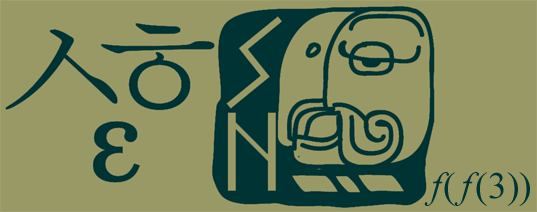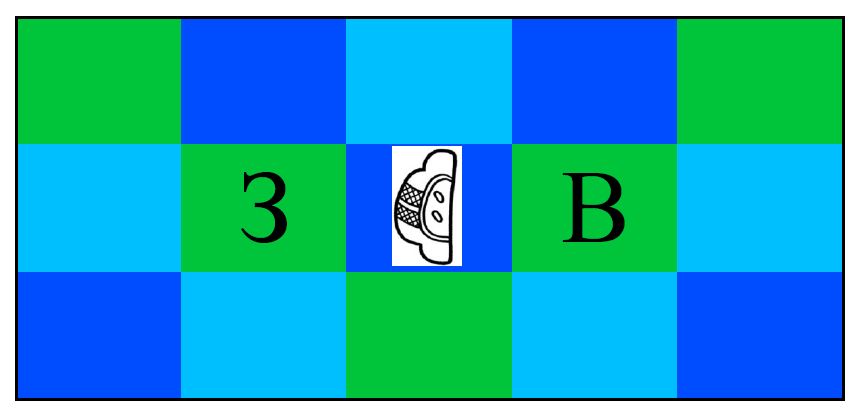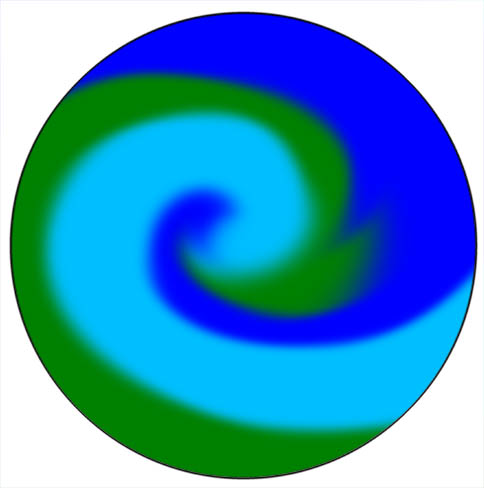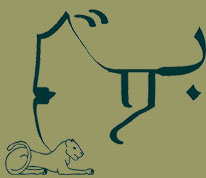 |
 |
|||||||
 |
 |
|||||||
 |
||||||||

the f(f(x)) series
The program:
f(f(x)) is a symbolic stand-in for an entire class of enormously important and ecstatically fascinating processes: recursive functions. Simply f(x) would just be a standard function—a value is inserted in place of the x variable, and the function f spits out a result. Boring. Of course any value could theoretically be inserted in place of x, including another function, like, let's say g(x). That would give us f(g(x))—insert a value in the place of x and the function g spits out a result which is then immediately fed into the function f yielding a final result. Somewhat more interesting.
Often, incredibly interesting (and usually at least somewhat unpredictable) results occur when the value we plug into f(x) is ITSELF; that is f(f(x)). This kind of recursivity is at the heart of fractals, such as the Mandelbrot set:
Fractals, and recursivity in general, are also very important in Chaos theory.
No pieces in this series are exclusively f(f(x)) compositions; the f(f(x)) part of the title (with x replaced by a number indicating its chronological place within the series) is always appended as a sub- or super-script to another title. The other title can be anything, but as of yet has always been one of my other series. That primary title refers to the overriding theme or structure of the entire work, but one of the many "fractal" aspects of these pieces is that there are many smaller compositions contained within the larger work. This is discussed further in the Series Structure section below.
Indeed, the pieces in the f(f(x)) series are concerned with any number of more-or-less metaphorical implementations of musical recursivity like this. For example, a lot of pieces in this series have melodies which are specifically constructed so that they contain themselves—that is to say that any version of the melody will line up with versions of itself at both slower and faster speeds. For example, if I have a melody like A - B - B - C - B - D - C - E - B etc, it lines up with itself when paired with half- or quarter-speed versions like so:
| A | B | B | C | B | D | C | E | B |
| A | - | B | - | B | - | C | - | B |
| A | - | - | - | B | - | - | - | B |
Obviously, only specially-composed melodies have this property, and I spent an inordinate amount of time figuring out an equation that would help me generate them. Similar to this, but transplanted into the rhythmic realm, I often use obssesive little motives that are irregularly accented. After each note has been accented, the pattern starts again but now in the order of the previously accented notes. A third pattern is thus generated by the accented notes of the accented notes of the original, then a fourth by the accented notes of the accented notes of the accented notes of the original, etc. This probably makes no sense at all, so hereís an example:
Letís number the thumb and fingers of one of your hands 1-5. First tap the original pattern:
1-2-3-4-5
Not very exciting. Now letís accent every two hits:
1-2-3-4-5 | 1-2-3-4-5
Thereís a new emergent pattern now, 1-3-5-2-4. The next stage would be to change the finger pattern to this new arrangement, but to continue accenting every second hit:
1-3-5-2-4 | 1-3-5-2-4
The pattern that emerges for this second iteration is basically a backwards version of the original seed. Then we iterate again:
1-5-4-3-2 | 1-5-4-3-2
And again:
1-4-2-5-3 | 1-4-2-5-3
And just like that we have an emergent pattern identical to the original seed, and the cycle repeats itself. However, the rhythm expands slightly such that it is every third note accented rather than every second. This is an absolutely recursive structure. A process (accenting every n-th note) is applied to the result of a copy of the same process, which was in turn the result of yet another copy, etc.
If one applies this same kind of recursive treatment to the right kinds of mathematical functions, a phenomenon known as a strange attractor is born. It's way beyond the scope of this description to go into the details, but you should absolutely read Chaos by James Gleick if you're interested. At any rate, a third kind of melodic pattern often featured in f(f(x)) pieces mimics these fascinating forms: single notes are "captured" and propagate through a wild assortment of pitches that quickly converge around a set pitch or cycle of pitches.
As mentioned earlier, the program of the series is ultimately about structural forms within forms, so let's move on to the next section.
The structure:
Pieces in this series:
PortRait of the ArTist,**NYC2001
Solo Cello and Recorded Electronics
Summer '01
more info








